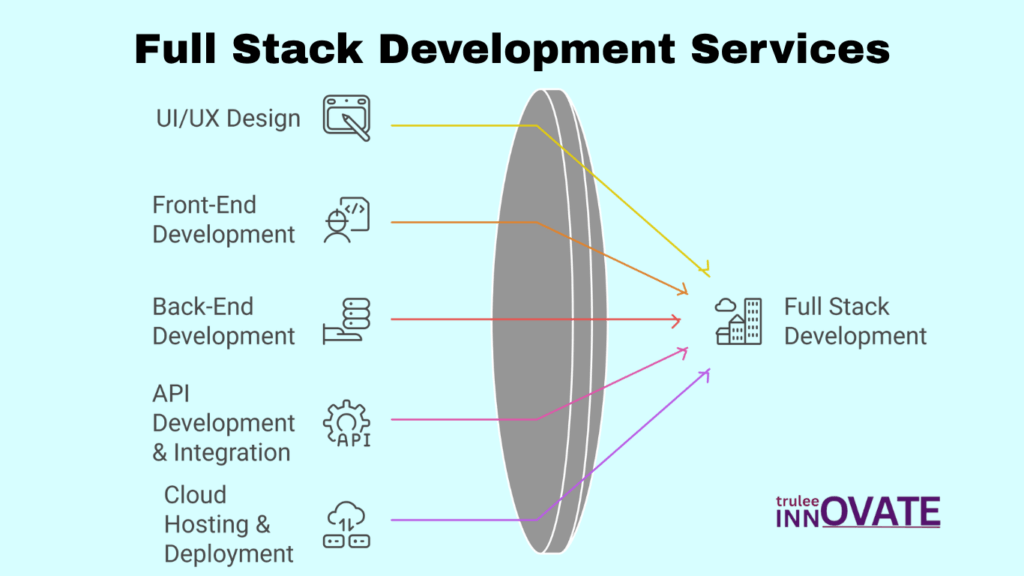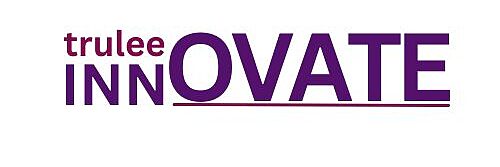Whether it’s a website, online application, or mobile platform, creating a digital product involves more than simply an innovative idea. It requires a strong team, appropriate technology, and an effective, scalable development process.
However, a lot of companies have trouble with disjointed workflows. Hiring distinct system architects, UI/UX designers, back-end engineers, and front-end developers may easily become costly and disorganized. Miscommunications occur, deadlines are extended, and expenses mount.
For this reason, a lot of businesses are using full stack development services, which are a streamlined, one-stop shop that handles everything from design to deployment. The outcome? Increased return on investment (ROI), enhanced teamwork, and quicker delivery.
Let’s examine how this cutting-edge method to development can help your company grow more easily, launch more quickly, and build smarter—all without going over budget.
What Are Full Stack Development Services?
Services for full stack development cover every step required to create a web or mobile application from beginning to end. You work with a single team that manages everything, from strategy and design to development, deployment, and even maintenance, as opposed to managing distinct teams for your server/database logic (back-end) and user interface (front-end).
This cohesive strategy not only streamlines the development process but also shortens turnaround times and lowers expenses.
What’s Included in Full Stack Development?
When you work with a full stack development team, you’re not just getting coders—you’re getting partners who handle your entire product from start to finish. Here’s what that typically looks like:
- User-Friendly Design (UI/UX)
It all starts with creating an experience your users will love. Full stack teams design clean, intuitive interfaces that feel easy and natural to use—no clutter, no confusion. - Front-End Development
This is what users see and interact with: the look, the buttons, the responsiveness. Tools like React, Angular, or Vue help build sleek, fast front-ends that work beautifully on any screen size. - Back-End Development
Now we get to the stuff under the hood—things like servers, logic, and databases. Using tools like Node.js, Python, PHP, or Java, full stack developers make sure everything runs smoothly behind the scenes. - Databases & API Integration
Whether it’s storing user data or integrating services like payment gateways or CRMs, your team handles it all seamlessly, connecting the dots so your app functions as one polished system. - Cloud Hosting & Deployment
Once everything’s built, your product needs a home. Whether it’s AWS, Azure, or Google Cloud, full stack teams get it live, scalable, and secure—so you can focus on growth, not downtime.

Why Full Stack Development Services Are a Smart Business Investment
Now that you know what’s included, let’s dive into why full stack development is a smart move for your business.
One Team, Full Ownership
Imagine not having to coordinate between multiple teams, bounce between toolsets, or wait days for handoffs.
With a full stack team:
- Collaboration is seamless
- Communication is smooth
- The product architecture is fully cohesive
This end-to-end ownership speeds up development and reduces the chances of costly errors.
Cost-Efficient from Day One
Organizations often think hiring multiple specialists equals best results. Not true.
With full stack services:
- You pay one provider, not several contractors
- There’s no need to maintain an internal dev team
- You avoid duplicated tools and processes
This leaner, more efficient approach makes custom development more accessible for startups and SMBs.
Faster Time to Market
Speed matters—especially if you’re releasing an MVP or racing to beat the competition.
Full stack developers can:
- Build prototypes quickly
- Iterate faster based on feedback
- Launch updates independently without coordination delays
All of this gives your business a serious time advantage.
Flexibility as You Scale
Your business needs today may not look the same in six months—and that’s okay.
Full stack developers are jacks-of-all-trades who can:
- Add features as your users demand them
- Switch tech stacks if your direction changes
- Integrate third-party solutions (like analytics, CRMs, or payment platforms)
This adaptability is invaluable for growing businesses and tech-focused startups.
When Is Full Stack Development Services the Best Option?
Not every project requires full-stack support but many do. Going full stack makes the most sense in the following situations:
You’re developing an MVP or SaaS product. Startups in their early stages require cost, speed, and flexibility. All three are delivered by a full stack team.
You Lack a Committed Technical Staff
A complete stack agency can serve as an external CTO and development team for non-technical founders or small businesses.
You require scalability and ongoing support.
You will still require bug patches, updates, and new features after launch. This is more efficient and economical when there is a single full stack partner.
How to Choose the Right Full Stack Development Partner
Development companies are not all made equal. Here’s how to identify one that’s worth the money.
1. Check Their Technical Stack
Seek for cross-functional knowledge. Stacks that are ideal include:
- Front-end: Vue, Angular, and React
- Back-end: Django, Laravel, and Node.js
- Cloud/DevOps: AWS, Azure, Google Cloud, Docker, CI/CD pipelines; databases: PostgreSQL, MongoDB
- They should also be proficient in contemporary security procedures, mobile-friendly design, and API development.
2. Evaluate Communication & Collaboration
Consider this:
- Is there a specialized project manager available?
- Do they use Scrum or Agile development methodologies?
- Are they able to meet frequently and operate in your time zone?
- Effective communication is essential for successful product development, not merely a b
3. Experience in your field is really important.
For instance:
- Healthcare: Systems that comply with HIPAA
- Fintech: Safe transactions and adherence to regulations
- E-commerce: Smooth integrations and checkouts
- EdTech: Scalable systems with tracking and video capabilities
- An experienced partner cuts down on your ramp-up time by getting started right away.
Final Thoughts: A Smarter Path to Tech Growth
Full stack development services aren’t just technical teamwork—they’re a practical business strategy.
Whether you’re a founder building your first product, or a company scaling your software, this approach provides:
✅ Lower cost
✅ Faster delivery
✅ Streamlined operations
✅ Long-term scalability
If you’re looking for a smarter, leaner path to product development, full stack development is a solid investment with excellent ROI.
1. Is full stack development suitable for large-scale enterprise projects?
Yes. Many enterprises use full stack teams for internal tools, web portals, and microservice-based platforms—just make sure the team has enterprise-level experience.
2. How much do full stack development services cost?
Pricing varies by location and scope. Expect anywhere from $25 to $100/hour, or fixed-price packages for MVPs ranging between $10K–$50K, depending on complexity.
3. What technologies should a full stack developer know in 2025?
Key technologies include:
Front-end: React, Vue
Back-end: Node.js, Python, PHP
Databases: PostgreSQL, MongoDB
Cloud/DevOps: AWS, Docker, CI/CD tools
4. Can full stack development be outsourced securely?
Yes—just take precautions:
Sign NDAs and data privacy agreements
Use private GitHub or GitLab repositories
Limit access based on roles
Choose vendors with ISO or SOC2 compliance
5. How long does it take to build a full stack app?
MVP: 4–12 weeks
Fully-featured app: 3–6 months, depending on scope


